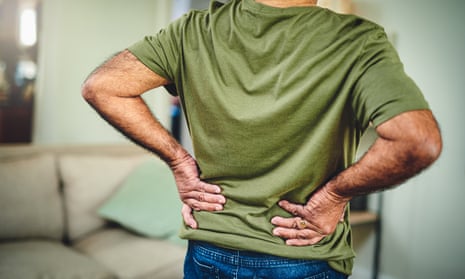Rise in back pain and long-term sickness linked to home working – ONS
Poor ergonomics contributed to number of ‘economically inactive’ people and to UK’s labour shortage

Anybody who emerged from the Covid-19 lockdowns with a frozen shoulder or a neck crick after spending hours hunched over their laptop at the kitchen table would be painfully aware of the dangers of working from home.
Now the nation’s number crunchers have provided evidence that remote working may be partly to blame for the UK’s chronic labour shortage, with tens of thousands of extra people reporting as long-term sick due to lockdown related injuries.
In a sign that poor ergonomics can have an impact on economics, the Office for National Statistics found a big rise in the number of people being unfit for work because of neck and back injuries. Overall, the ONS said the number of people identified as economically inactive because of long-term sickness had increased from 2 million to 2.5 million in the three years from 2019, with more than 70% of the rise – 363,000 – occurring after the arrival of Covid in early 2020.
But a breakdown of the total showed that the number leaving the labour force because of neck and back problems rose by 62,000 – the second-largest reason cited.
Gavin Burt, a registered osteopath and clinic director of Backs & Beyond in London, said he was unsurprised by the ONS figures because he saw a significant increase in patients coming to him with back and neck problems, particularly people in their twenties.
“In an office you have a really well-designed ergonomic set-up, which helps to reduce repetitive strain injury (RSI) and back pain. But we never really think about ergonomics at home.”
Burt, a member of the General Osteopathic Council, added: “People were working with one leg on the bed, one leg off the bed, in a slightly contorted position on their laptop or at uncomfortable dining chairs or sofas. Basically it is overuse injuries, in poor posture for longer than they would have done if they were working in an office.”
The ONS said older people continued to make up the majority of those inactive because of long-term sickness, but the sharpest relative increases in recent years had been among those aged 25 to 34. Long-term sickness in that age category rose by 42%, compared with a 16% jump for people aged between 50 and 64.
Hugh Stickland, an ONS senior statistician, said: “The largest increase came from people with ‘other health problems or disabilities’. While this category includes people affected by long Covid, we think that’s only one of several contributing factors. The next highest rise was among people with back or neck problems; it’s possible that increased home working has given rise to these kinds of conditions.”
Burt said he had already noticed an improvement in some of his clients, which he attributes to the part-time return to office working, and the associated commute, particularly for those who travel on public transport.
“People often think of the commute as a chore, but it got people up and walking,” Burt said. “I’ve already seen people’s conditions improve by moving to hybrid working, getting back on to the commute and once they are up and about and going somewhere else, it gives them the emotional space to think about exercise.”
The rising number of economically inactive people has been a key factor behind the labour shortages that have alarmed the Bank of England and contributed to higher interest rates this year.
Lockdowns during the pandemic led to an increase in the number of economically inactive people reporting depression, “bad nerves” and anxiety as their main health condition in 2020 and 2021, but the ONS said numbers had now returned to pre-pandemic levels.
Alison Carter, a researcher in HR leadership and wellbeing at the Institute of Employment Studies, said employers should focus on making sure their staff have workplace assessments for their office and home set-ups,
“From an employee wellbeing point of view, we need to encourage people back to work who are dropping off the radar and if musculoskeletal problems are the reason, there are physical workplace adjustments that can be made,” she said.
- Working from home
- Britain’s missing workers
- Office for National Statistics
- Health
- Back pain
- Work & careers
- Coronavirus
- news

